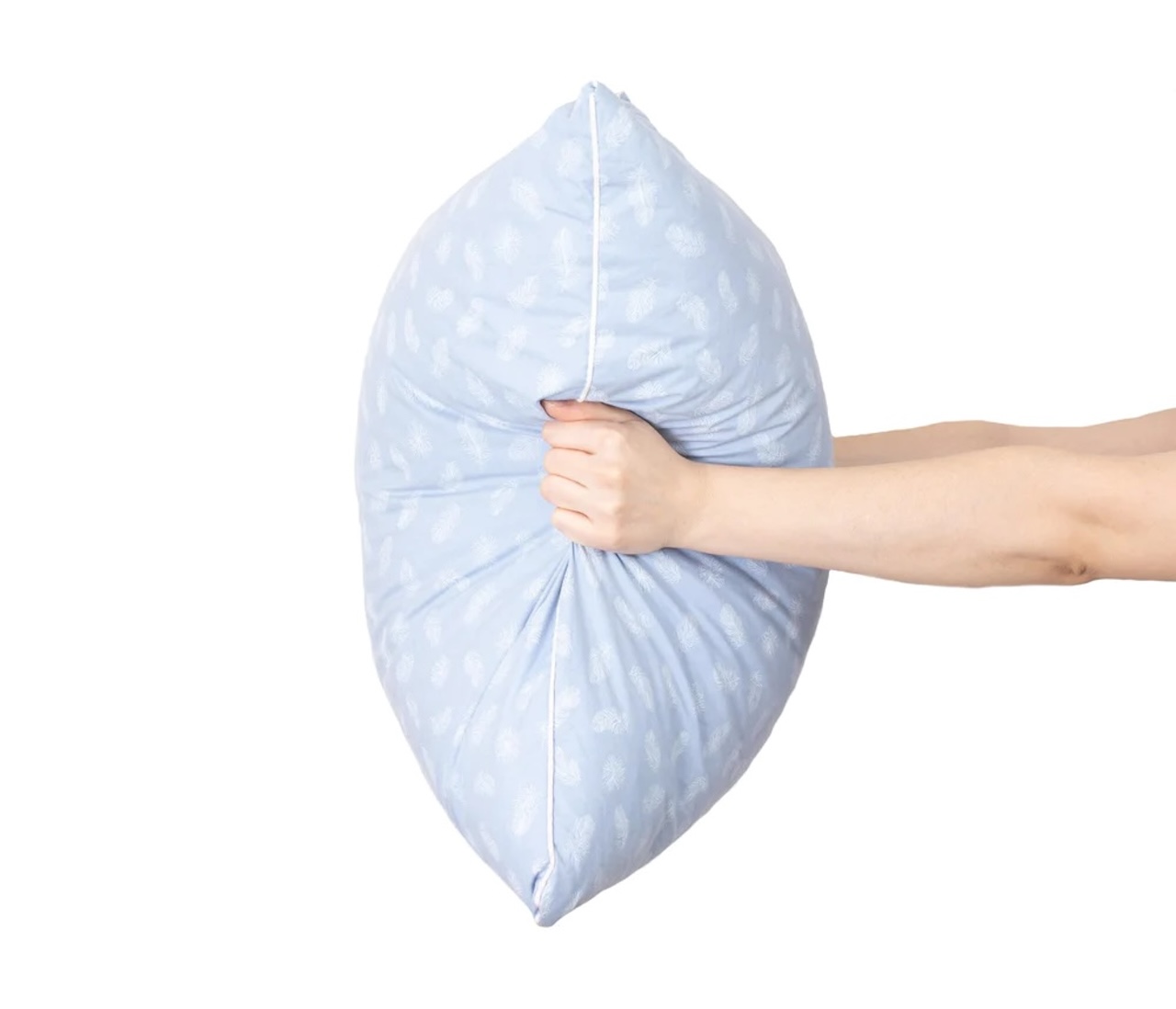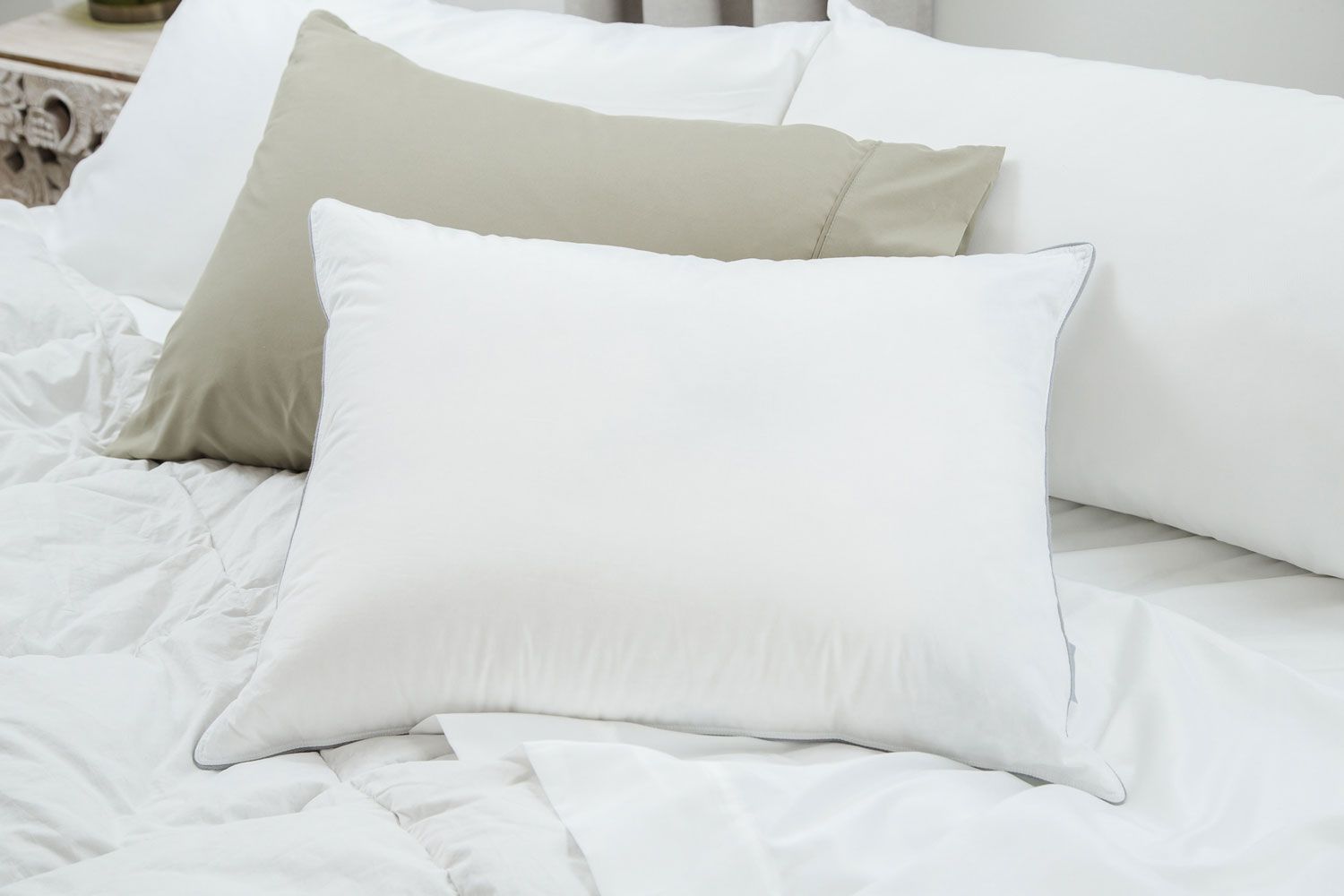

Articles
Why Do We Sleep On Pillows
Modified: October 18, 2024
Discover the importance of pillows for quality sleep in our informative articles. Learn why we sleep on pillows and how they enhance our comfort and relaxation.
(Many of the links in this article redirect to a specific reviewed product. Your purchase of these products through affiliate links helps to generate commission for Storables.com, at no extra cost. Learn more)
Introduction
Sleep is an essential part of our daily routine, allowing our bodies and minds to rejuvenate and recharge. And what better way to enhance the quality of our slumber than by using pillows? Pillows have been a staple of human comfort for centuries, providing support and comfort for our heads, necks, and shoulders while we rest. But have you ever wondered about the history and significance of pillows in sleep? In this article, we will delve into the historical background of pillows and explore the role they play in our sleep routines.
Since ancient times, pillows have played a crucial role in our comfort during sleep. The use of pillows can be traced back to ancient civilizations such as Mesopotamia, Egypt, and China. These early pillows were made from various materials including stone, wood, and even porcelain. They were primarily used by the wealthy elite to ensure a more comfortable sleep experience.
As time progressed, pillows evolved, and new materials were introduced. In ancient Egypt, for example, pillows were often filled with reeds or feathers. These materials provided a softer and more comfortable surface for individuals to lay their heads on. The use of pillows spread to other cultures, including Greece and Rome, where pillows became a symbol of luxury and status.
Fast forward to the modern era, and pillows have become a household staple. Today, we have a wide array of pillow options available, each designed to cater to individual comfort preferences and sleep positions. Whether you prefer a firm pillow, a soft pillow, or one specifically designed to alleviate neck pain, there is a perfect pillow out there for you.
But what exactly is the role of a pillow in sleep? Why do we sleep on pillows in the first place? The primary function of a pillow is to provide support and alignment for the head, neck, and shoulders while we sleep. A well-chosen pillow can help maintain proper spinal alignment, reducing the risk of pain and discomfort during sleep and promoting a more restful slumber. Additionally, pillows serve to cushion pressure points and distribute weight evenly, preventing the development of pressure sores and promoting blood circulation.
In the following sections, we will explore the benefits of sleeping on pillows, the different types of pillows available, how to choose the right pillow for your needs, common misconceptions about sleeping on pillows, and tips for maintaining and taking care of your pillow. So, grab your favorite pillow, get comfortable, and join us as we embark on a journey into the captivating world of pillows and sleep!
Key Takeaways:
- Pillows have a rich historical background, evolving from ancient stone headrests to a wide array of options today, offering unique benefits such as spinal alignment, pressure relief, and sleep condition management.
- Choosing the right pillow is crucial for optimal sleep quality, considering factors like sleep position, firmness, material, and specific needs. Proper maintenance ensures longevity and hygiene for a rejuvenating sleep experience.
Read more: Why Do We Do Easter Baskets
Historical Background of Pillows
The use of pillows can be traced back thousands of years to ancient civilizations. The exact origin of the pillow is uncertain, but evidence suggests that early pillows were used as early as 7,000 BC in Mesopotamia. These pillows were typically made from stone and were more like headrests than the plush pillows we are familiar with today.
In ancient Egypt, pillows were a symbol of status and wealth. They were often ornately decorated and filled with soft materials such as feathers, reeds, or even straw. Egyptian pillows were not just used for sleep; they also played a ceremonial role. It was believed that the pharaohs’ dreams held important messages from the gods, so their heads were elevated on pillows to ensure a clear channel of communication.
In ancient China, pillows were seen as a way to maintain proper alignment of the body during sleep. Chinese pillows were made of various materials, including wood, bamboo, and jade. These pillows were often curved or contoured to support the head and neck and promote good posture while sleeping. The Chinese also believed that pillows made from certain materials, such as jade, had therapeutic properties and could help balance the body’s energy.
As pillows made their way to ancient Greece and Rome, they became more accessible to the general population. However, pillows were still considered a luxury item and were primarily used by the upper-class citizens. Greek and Roman pillows were made of softer materials, such as feathers and animal wool, for added comfort.
During the Middle Ages, pillows became more widely used as a symbol of social status. The size and shape of the pillow were often indicative of a person’s rank in society. Those with more wealth and higher social standing had larger, more elaborately decorated pillows.
In the Renaissance period, pillows became even more extravagant. European pillows were often adorned with intricate embroidery and lace, and some were even stuffed with fragrant herbs and flowers for a pleasant scent.
As technology and industrialization advanced, the manufacturing process for pillows became more efficient. This led to the mass production of pillows, making them more affordable and accessible to people from all walks of life.
Today, pillows come in a wide variety of shapes, sizes, and materials. From memory foam pillows designed to conform to your body’s shape to hypoallergenic pillows for individuals with allergies, there is a pillow to suit everyone’s needs and preferences.
The historical background of pillows not only sheds light on their evolution throughout time but also highlights the significant role they have played in human comfort and well-being. So, the next time you rest your head on a soft, fluffy pillow, remember the rich history behind this seemingly simple object.
The Role of Pillows in Sleep
Pillows play a vital role in ensuring a comfortable and restful night’s sleep. They provide support and alignment for the head, neck, and shoulders, helping to maintain proper spinal alignment and reducing the risk of pain and discomfort. Let’s explore the various ways in which pillows contribute to a better sleep experience.
One of the primary functions of a pillow is to support the head. When we lay down to sleep, our heads should be aligned with our spines to maintain a neutral position. A well-chosen pillow helps to keep the head in this proper alignment, preventing strain on the neck muscles and reducing the risk of waking up with a stiff neck.
Pillows also provide support for the neck. The neck contains delicate vertebrae and muscles that need proper support during sleep. A pillow that contours to the shape of the neck and offers adequate cushioning helps to relieve pressure on the neck and improve overall comfort. It prevents excessive bending or stretching of the neck, allowing the muscles to relax and facilitating a more restful sleep.
Additionally, pillows offer support for the shoulders. As we sleep, our shoulders should be relaxed and supported to avoid any tension or strain. A pillow that fills the gap between the head and shoulders ensures proper alignment and distributes the weight evenly. This reduces pressure on the shoulders, preventing the development of pain or discomfort in that area.
By providing support for the head, neck, and shoulders, pillows help to alleviate pressure points. Pressure points are areas where the body’s weight is concentrated, and without proper support, they can become uncomfortable or painful. Pillows help to distribute the weight across a larger surface area, reducing the pressure on specific points and promoting better blood circulation. This prevents the development of pressure sores and improves overall sleep quality.
Another role of pillows in sleep is to enhance comfort. The right pillow can create a cozy and inviting sleep environment. The softness, loft, and texture of the pillow contribute to the overall comfort level, allowing us to relax and unwind more easily. A comfortable pillow can help us fall asleep faster and stay asleep longer, ensuring a more rejuvenating experience.
It’s important to note that the role of pillows in sleep can vary depending on personal preferences and individual needs. Different sleep positions (such as back, side, or stomach) require different types of pillows to provide optimal support. Some individuals may require more firmness in their pillow to prevent excessive sinking, while others may prefer a softer and more cushioned option for a plush feel.
In the next sections of this article, we will explore the different types of pillows available and provide insights on choosing the right pillow for your sleep needs. So, whether you are a back sleeper, side sleeper, or stomach sleeper, there is a perfect pillow out there to enhance your sleep experience and ensure that you wake up feeling refreshed and ready to take on the day.
Benefits of Sleeping on Pillows
Sleeping on pillows offers numerous benefits that contribute to a restful and rejuvenating night of sleep. Let’s delve into some of the key advantages of using pillows while you sleep.
1. Enhanced Comfort: One of the primary benefits of sleeping on pillows is the increased comfort it provides. Pillows offer a soft and supportive surface for your head, neck, and shoulders, allowing you to relax and unwind more easily. The plushness of the pillow creates a cozy environment that promotes a sense of relaxation, helping you fall asleep faster and stay asleep longer.
2. Proper Spinal Alignment: A crucial benefit of using pillows is the ability to maintain proper spinal alignment during sleep. When you rest your head on a pillow that supports and aligns your neck with your spine, you reduce the risk of waking up with neck or back pain. Proper spinal alignment ensures that the weight of your head is distributed evenly, preventing strain on the vertebrae and muscles in these areas.
3. Pressure Relief: Pillows offer excellent pressure relief by distributing your weight evenly and cushioning your pressure points. This prevents the development of pressure sores and improves blood circulation, reducing the likelihood of waking up with numbness or tingling in your extremities. By relieving pressure, pillows enhance overall comfort and allow for a more restful sleep experience.
4. Breathability and Temperature Regulation: Many pillows are designed with breathability in mind. They feature materials and designs that enhance air circulation, preventing the buildup of heat and moisture. By facilitating better temperature regulation, pillows help you maintain a comfortable and cool sleep environment, reducing the likelihood of overheating and night sweats.
5. Allergy Prevention: Several pillows are specially designed for individuals with allergies or asthma. These pillows are hypoallergenic, resistant to dust mites, and made from materials that inhibit the growth of allergens. Using hypoallergenic pillows can help reduce the presence of allergens in your sleep environment, allowing for a more allergy-free and comfortable sleep.
6. Sleep Apnea Management: For individuals with sleep apnea or other breathing difficulties during sleep, certain pillows can be beneficial. These pillows are designed to elevate the head, neck, and chest, opening up the airways and facilitating easier breathing. By promoting better airflow, these pillows can help manage the symptoms of sleep apnea and improve sleep quality.
7. Neck and Muscle Support: Pillows that provide proper neck support can help relieve tension and strain in the neck muscles. This can be particularly beneficial for individuals who experience neck pain or stiffness. Additionally, pillows that have specific design features, such as memory foam or contouring, can offer targeted support to different areas of the body, helping to alleviate muscle aches and pains.
These are just a few of the many benefits that pillows offer for sleep. The right pillow can make a significant difference in your sleep quality and overall well-being. In the next sections, we will explore the different types of pillows available and provide insights on choosing the perfect pillow to suit your individual needs and preferences.
Different Types of Pillows
When it comes to pillows, there is no one-size-fits-all solution. Different types of pillows are designed to cater to various sleep preferences, positions, and specific needs. Understanding the different options available can help you choose the perfect pillow to suit your requirements. Let’s explore some of the most common types of pillows:
1. Memory Foam Pillows: Memory foam pillows are known for their exceptional contouring and support. They are made from viscoelastic foam that molds to the shape of your head and neck, providing personalized support and pressure relief. Memory foam pillows are ideal for individuals who prefer a pillow that conforms closely to their body and provides excellent neck and spine alignment.
2. Down Pillows: Down pillows are made from the soft plumage found beneath the feathers of ducks or geese. These pillows are known for their exceptional softness and loft, creating a luxurious sleep experience. Down pillows offer excellent support and can be fluffed and shaped to suit personal preferences. They are a popular choice for individuals who enjoy a softer and more plush pillow.
3. Latex Pillows: Latex pillows are made from natural latex derived from rubber tree sap or synthetic latex. They are known for their durable and responsive nature. Latex pillows offer a good balance of support and softness, providing pressure relief and maintaining proper alignment. They are also hypoallergenic and resistant to dust mites, making them an excellent choice for individuals with allergies.
4. Buckwheat Pillows: Buckwheat pillows are filled with the hulls of buckwheat seeds. These pillows conform to the shape of the head and neck and provide excellent support. Buckwheat pillows are known for their breathability and ability to dissipate heat, making them ideal for individuals who tend to sleep hot. They also offer adjustable firmness by adding or removing the buckwheat hulls.
5. Feather Pillows: Feather pillows are filled with the outer feathers of ducks or geese. These pillows offer a combination of softness and support, as the feathers can be fluffed and shaped to suit individual preferences. Feather pillows are known for their breathability and durability, making them a popular choice for sleepers who prefer a moldable and plush pillow.
6. Microfiber Pillows: Microfiber pillows are made from synthetic fibers that mimic the softness and loft of down pillows. These pillows are hypoallergenic, breathable, and offer excellent support and durability. Microfiber pillows are a great option for individuals with allergies or those who prefer a less expensive alternative to down pillows.
7. Cervical Pillows: Cervical pillows are specifically designed to support the natural curve of the neck. They have a contoured shape with a higher portion in the middle and lower sides to cradle the neck. Cervical pillows help alleviate neck pain, promote proper spinal alignment, and provide targeted support to the neck and shoulders.
These are just a few examples of the different types of pillows available on the market. When choosing a pillow, consider factors such as your preferred sleep position, desired level of support, and any specific needs or conditions you may have. By selecting the right pillow, you can enhance your sleep quality and wake up feeling refreshed and rejuvenated.
Choose a pillow that provides proper support for your head and neck to help maintain proper spinal alignment while sleeping. This can help reduce neck and back pain and improve overall sleep quality.
Read more: Why Do We Use CAD
Choosing the Right Pillow for Your Needs
When it comes to choosing the right pillow, there is no one-size-fits-all solution. The perfect pillow for you will depend on various factors, including your sleep preferences, sleep position, and any specific needs or conditions you may have. Here are some key considerations to keep in mind when selecting a pillow:
1. Sleep Position: Your preferred sleep position plays a significant role in determining the type of pillow that will best support your head and neck. Different sleep positions require different levels of support. For example:
- Back Sleepers: Back sleepers usually benefit from a pillow that provides medium support to maintain the natural curve of the spine.
- Side Sleepers: Side sleepers typically require a pillow with higher loft to fill the gap between the head and shoulders and keep the spine aligned.
- Stomach Sleepers: Stomach sleepers generally need a flatter and softer pillow to prevent excessive neck strain.
2. Firmness Level: The firmness level of a pillow is a personal preference that depends on your desired level of support and comfort. Some individuals prefer a firm pillow that provides extra support, while others prefer a softer and more cushioned feel.
3. Material: Different pillow materials offer various benefits. Memory foam pillows offer excellent contouring and support, while down pillows provide a plush and luxurious feel. Consider your preferences regarding materials like latex, buckwheat, feather, or microfiber based on your comfort and any specific needs, such as allergies or breathability.
4. Allergies and Asthma: If you have allergies or asthma, consider hypoallergenic pillows that are resistant to dust mites and made from materials that inhibit the growth of allergens. Look for pillows specifically labeled as hypoallergenic or made with allergen-resistant materials.
5. Pillow Loft: The loft refers to the height or thickness of a pillow. The ideal loft will depend on your sleep position and personal preferences. Side sleepers usually benefit from a higher loft to maintain proper spinal alignment, while stomach sleepers may prefer a lower loft to prevent neck strain.
6. Neck and Shoulder Support: If you experience neck or shoulder pain, consider pillows that offer targeted support to these areas. Cervical pillows, for example, have a contoured shape that cradles the neck and promotes proper spinal alignment.
7. Temperature Regulation: If you tend to sleep hot, consider pillows with cooling properties, such as those made with breathable materials or infused with gel or cooling technology. These pillows can help regulate your body temperature and keep you comfortable throughout the night.
8. Pillow Maintenance: It’s important to consider how easy or difficult a pillow is to maintain. Some pillows come with removable and washable covers, making it easier to keep them clean and fresh.
Ultimately, the right pillow for you is the one that meets your individual needs and provides the support and comfort necessary for a good night’s sleep. Pay attention to your preferences, sleep positioning, and any specific conditions you may have to make an informed decision.
When you find the perfect pillow, it can significantly enhance the quality of your sleep and contribute to your overall well-being. So take the time to explore the various options available, try out different pillows, and don’t be afraid to invest in a high-quality pillow that will provide you with the comfort and support you deserve.
Common Misconceptions About Sleeping on Pillows
There are several common misconceptions surrounding the use of pillows when it comes to sleep. Let’s debunk some of these misconceptions and shed light on the truth:
1. “The more pillows, the better”: Many people believe that using multiple pillows will automatically lead to better sleep. However, this is not necessarily true. While it’s important to find the right pillow for your needs, using too many pillows can actually lead to poor neck and spinal alignment, causing discomfort and disrupted sleep. One or two appropriately supportive pillows are usually sufficient.
2. “Firm pillows are always better”: While some individuals prefer firm pillows for added support, not everyone needs or benefits from a firm pillow. The ideal firmness level of a pillow is subjective and depends on personal comfort preferences and sleep needs. Some individuals find softer pillows more comfortable and supportive for their sleep positions and body types. It’s essential to choose a pillow that offers proper support and aligns with your specific needs, regardless of its firmness level.
3. “All pillows are the same”: This is a common misconception that overlooks the wide variety of pillows available. Different types of pillows serve different purposes and cater to individual preferences and needs. From memory foam to down pillows, each type offers unique features and benefits. It’s important to explore different options and select a pillow that aligns with your sleep position, desired level of support, and personal comfort preferences.
4. “Pillows don’t need to be replaced regularly”: Pillows, like any other household item, have a lifespan. Over time, pillows accumulate dust mites, dead skin cells, and allergens, becoming less supportive and hygienic. As a general guideline, it’s recommended to replace your pillows every 1 to 2 years, or when they start losing shape and support. Regularly replacing your pillows ensures optimal comfort, support, and cleanliness during sleep.
5. “Sleeping without a pillow is better for your posture”: Some individuals believe that sleeping without a pillow is beneficial for maintaining proper posture. However, this is not true for everyone. The optimal sleep posture varies depending on factors such as sleep position, mattress firmness, and individual body anatomy. For most people, a well-chosen pillow that supports the natural curve of the neck and allows for proper spinal alignment is essential for maintaining good posture while sleeping.
6. “Pillows don’t affect sleep quality”: The quality of your pillow can significantly impact your sleep experience. A supportive and comfortable pillow ensures proper spinal alignment, pressure relief, and enhanced overall comfort during sleep. On the other hand, an inadequate pillow can lead to neck pain, discomfort, and disrupted sleep. Choosing the right pillow for your needs and preferences is crucial for optimizing sleep quality and waking up refreshed.
By debunking these common misconceptions, we can better understand the importance of selecting the right pillow and debunking these common misconceptions assists in creating a more informed approach to sleep health. Remember, finding the right pillow for you is a personal journey that requires understanding your own sleep needs and preferences. So, take the time to explore different options, try out pillows, and prioritize your comfort and support during sleep.
Maintaining and Taking Care of Your Pillow
To ensure the longevity and optimal performance of your pillow, it’s important to properly maintain and care for it. Here are some essential tips for keeping your pillow clean and in good condition:
1. Regular Fluffing: Fluff your pillow regularly to help maintain its shape and loft. This is particularly important for pillows filled with feathers, down, or synthetic materials. Fluffing the pillow redistributes the filling and prevents it from becoming flat or lumpy.
2. Use a Pillow Protector: Consider using a pillow protector or pillowcase to shield your pillow from dust, dirt, sweat, and natural body oils. A pillow protector acts as a barrier, reducing the amount of debris that penetrates the pillow and making it easier to clean.
3. Wash According to Instructions: Check the care instructions provided by the manufacturer and follow them carefully when washing your pillow. Different types of pillows require different cleaning methods. Some pillows can be machine-washed, while others may need to be spot-cleaned or dry-cleaned. Washing your pillow regularly helps remove allergens, dust mites, and sweat, ensuring a clean and hygienic sleep surface.
4. Allow for Proper Drying: After washing your pillow, make sure it is thoroughly dry before using it again. Damp or moist pillows can foster the growth of mold, mildew, and bacteria. Follow the manufacturer’s recommendations for drying or air-dry the pillow in a well-ventilated area to ensure complete drying.
5. Use a Pillowcase: Always use a pillowcase to protect your pillow from stains, spills, and body oils. Pillowcases are easier to clean and can be changed frequently, ensuring a hygienic sleep environment.
6. Rotate and Replace When Necessary: Rotate your pillow regularly to distribute wear and tear evenly. This helps extend the lifespan of your pillow. Additionally, pay attention to the signs that indicate it’s time to replace your pillow. If your pillow has lost its shape, provides inadequate support, or shows signs of wear and tear, it may be time for a new one.
7. Consider Pillow Refreshing: Some pillows, such as memory foam or latex pillows, cannot be washed entirely. In these cases, consider using a pillow refreshing spray or powder to eliminate odors and refresh the pillow’s surface. Follow the instructions provided by the manufacturer to ensure safe and effective use.
8. Avoid Excessive Force: Be mindful when handling and positioning your pillow. Avoid folding, bending, or putting excessive force on it, as this can damage the pillow’s structure and compromise its performance.
By following these maintenance and care tips, you can keep your pillow in excellent condition and ensure a clean and hygienic sleep environment. Remember that proper pillow maintenance not only improves your sleep experience but also promotes your overall health and well-being.
Conclusion
Pillows have been an integral part of human sleep for centuries, providing support and comfort to help us rest and rejuvenate. Throughout history, pillows have evolved, offering a wide range of options to cater to individual preferences and needs. Understanding the role of pillows in sleep and choosing the right pillow can greatly enhance the quality of our slumber.
We have explored the historical background of pillows, from their use in ancient civilizations to the diverse options available today. Pillows have come a long way, undergoing transformations in materials, design, and functionality to meet the ever-changing needs of sleepers.
The benefits of sleeping on pillows are numerous. They contribute to proper spinal alignment, alleviate pressure points, enhance comfort, and provide support for the head, neck, and shoulders. Pillows also play a role in managing conditions such as sleep apnea, allergies, and muscle aches.
There are various types of pillows to choose from, each offering unique features and benefits. Memory foam, down, latex, buckwheat, feather, and microfiber are among the different options available. By considering your sleep position, desired firmness, materials, and specific requirements, you can find the perfect pillow to suit your needs and preferences.
It’s important to dispel common misconceptions surrounding pillows, such as the belief that more pillows are always better or that all pillows are the same. By understanding the realities and individual variations, you can make informed decisions about your sleep environment.
Finally, maintaining and caring for your pillow is essential to prolong its lifespan and ensure hygiene. Regularly fluffing, using pillow protectors, following washing instructions, and replacing pillows when necessary are all important steps in maintaining their performance and cleanliness.
Remember, sleep is a vital part of our well-being, and pillows play a significant role in facilitating a restful and rejuvenating slumber. So, invest the time and effort in choosing and caring for the right pillow that will support your sleep needs and preferences. With the perfect pillow by your side, you can rest easy and wake up ready to conquer each day with renewed energy and vitality.
Frequently Asked Questions about Why Do We Sleep On Pillows
Was this page helpful?
At Storables.com, we guarantee accurate and reliable information. Our content, validated by Expert Board Contributors, is crafted following stringent Editorial Policies. We're committed to providing you with well-researched, expert-backed insights for all your informational needs.















0 thoughts on “Why Do We Sleep On Pillows”